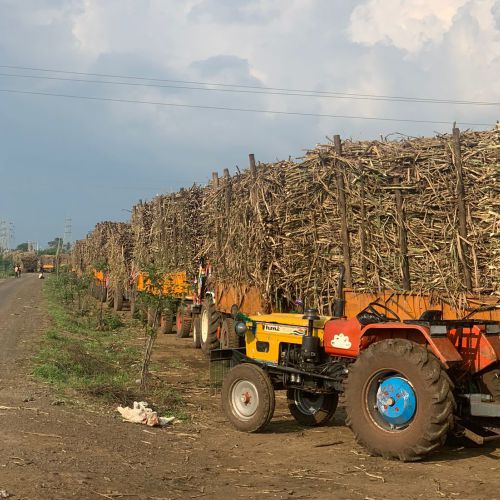The Indian sugarcane industry faces a critical juncture. Traditionally, bullock carts have been the workhorse for transporting sugarcane cuttings from fields to factories. However, a shift towards tractors for hauling has emerged, creating an unforeseen financial burden on sugar mills and ultimately impacting sugarcane farmers. This document details the urgency of establishing fair and sustainable transportation rates for tractors in the sugarcane sector.
“Aba Patil, Managing Director of Sahyaadri Sugar Mill, Satara, originally brought up this pressing issue in the Managing Directors Association. Sahkar Sagh, Harvesting Arbitrator’s, Together, the cooperative department and the state government must address this urgent issue and decide how to proceed in order to stop this problem from getting worse in the future.”
From Bullock Carts to Tractors: A Shift in Transportation
Sugarcane harvesting involves cutting the stalks into manageable pieces. These cuttings then need to be transported to processing mills. Historically, bullock carts, typically pulled by two bullocks and manned by two laborers, were the primary mode of transportation. Recognizing the combined effort involved, the government-appointed arbitrator established relatively high transportation rates for bullock carts. These rates factored in the wages for both laborers and the cost of maintaining the bullocks, ensuring fair compensation for the distance traveled (typically around 10 kilometers).
However, in recent times, the number of bullock carts has dwindled, replaced by the efficiency and speed of tractors. While initially adopted as a temporary solution, the use of tractors has skyrocketed. While this shift offers advantages in terms of hauling capacity and speed, a crucial aspect remains unaddressed – the lack of established transportation rates for tractors.
The Flaw in the System: Applying Bullock Cart Rates to Tractors
Since no official rates exist for tractor transportation, sugar mills are forced to negotiate with contractors. Unfortunately, in the absence of regulations, these negotiations often result in inflated charges. The problem arises because the existing bullock cart rates, designed for short distances, are being applied to tractors that can cover significantly longer distances (up to 40 kilometers documented last season). This practice leads to a drastic increase in overall transportation costs for sugar mills.
Let’s illustrate the issue with an example. Suppose the current bullock cart rate for transporting sugarcane is ₹759.07 per ton for a distance of 10 kilometers (including commission). If the same sugarcane is cut by a gang and transported by a vehicle team (likely a truck), the cost comes to ₹657.34 per ton – a significant difference. However, applying the bullock cart rate to the same distance for tractor transportation results in a staggering ₹101.73 per ton more being spent.
For longer distances, the situation becomes even more alarming. While the cost comparison figures for distances beyond 10 kilometers are not provided, the document suggests a concerning trend. This uncontrolled rise in transportation costs due to inflated tractor rates significantly eats into the FRP (Fair and Remunerative Price) received by farmers for their sugarcane.
Consequences of Inaction: A Threat to Farmers and Factories
The current lack of regulation regarding tractor transportation rates has several detrimental consequences:
Reduced Farmer Profits: Since inflated transportation costs eat into the FRP received by farmers, they ultimately receive less money for their sugarcane crop. This negates the benefit of the increased FRP set by the central government.
Financial Strain on Sugar Mills: The exorbitant costs associated with unregulated tractor transportation create a financial burden on sugar mills. This can lead to reduced profitability and potentially force them to pass on the burden to farmers in the form of lower FRP.
Demise of the Gang Cutting System: The higher profits associated with mini tractor transportation compared to traditional bullock cart and gang cutting systems incentivize farmers to shift completely to tractors. This threatens the livelihood of those involved in the traditional system.
Safety Concerns: Due to the absence of proper regulations for mini tractor transportation, overloading is a common practice. This not only compromises road safety but also increases the risk of accidents.
A Call to Action: Towards a Sustainable Solution
To ensure a sustainable future for the sugarcane industry, immediate action is required:
Establishing Fair Tractor Rates: The government, in collaboration with sugar mills, arbitrators, and farmer representatives, needs to establish fair and transparent transportation rates for tractors. These rates should factor in the distance traveled, fuel costs, and maintenance expenses.
Enforcing Regulations: Stringent regulations regarding tractor weight limits and permits are crucial to address safety concerns.
Protecting Traditional Systems: Measures should be explored to safeguard the traditional gang cutting system, which employs a significant workforce. This could involve establishing a minimum wage for traditional methods to ensure fair compensation compared to tractor-based transportation.
Conclusion:
The issue of unregulated tractor transportation rates is a ticking time bomb for the Indian sugarcane industry. It threatens the financial stability of both farmers and factories. By working together, the government, sugar mills, and relevant stakeholders can establish a sustainable system that ensures fair compensation for all involved while also prioritizing safety regulations. Ignoring this issue will only lead to further financial difficulties for the industry and potential safety hazards. Let’s address this challenge head-on.
Disclaimer: The views and opinions expressed in the article by Dilip Patil, Managing Director of Samarth SSK Ltd., are solely his own.












